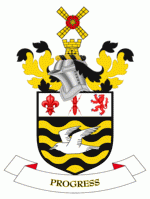Blackpool
 |
Throughout the Medieval and Early Modern period, Blackpool was a coastal hamlet in Lancashire's Amounderness Hundred and remained as such until the mid-18th century, when it became fashionable in England to travel to the coast in the summer to improve well-being. In 1781, visitors attracted to Blackpool's 7 mi sandy beach were able to use a new private road, built by Thomas Clifton and Sir Henry Hoghton. Stagecoaches began running to Blackpool from Manchester in the same year, and from Halifax in 1782. In the early 19th century, Henry Banks and his son-in-law John Cocker erected new buildings in Blackpool, which increased its population from less than 500 in 1801 to over 2,500 in 1851. St John's Church in Blackpool was consecrated in 1821.
Blackpool rose to prominence as a major centre of tourism in England when a railway was built in the 1840s connecting it to the industrialised regions of northern England. The railway made it much easier and cheaper for visitors to reach Blackpool, triggering an influx of settlers; in 1876, Blackpool was incorporated as a borough, governed by its own town council and aldermen. In 1881, Blackpool was a booming resort with a population of 14,000 and a promenade complete with piers, fortune-tellers, public houses, trams, donkey rides, fish and chip shops, and theatres. By 1901, the population of Blackpool was 47,000, by which time its place was cemented as "the archetypal British seaside resort". By 1951, it had grown to 147,000 people.
Shifts in tastes, combined with opportunities for British people to travel overseas, affected Blackpool's status as a leading resort in the late 20th century. Its urban fabric and economy both remain relatively undiversified and firmly rooted in the tourism sector, and the borough's seafront continues to attract millions of visitors every year. Blackpool's major attractions and landmarks include Blackpool Tower, Blackpool Illuminations, Pleasure Beach, Blackpool Zoo, Sandcastle Water Park, the Winter Gardens and Blackpool Tramway (the UK's only surviving first-generation tramway).
Map - Blackpool
Map
Country - United_Kingdom
 |
 |
| Flag of the United Kingdom | |
The United Kingdom has evolved from a series of annexations, unions and separations of constituent countries over several hundred years. The Treaty of Union between the Kingdom of England (which included Wales, annexed in 1542) and the Kingdom of Scotland in 1707 formed the Kingdom of Great Britain. Its union in 1801 with the Kingdom of Ireland created the United Kingdom of Great Britain and Ireland. Most of Ireland seceded from the UK in 1922, leaving the present United Kingdom of Great Britain and Northern Ireland, which formally adopted that name in 1927. The nearby Isle of Man, Guernsey and Jersey are not part of the UK, being Crown Dependencies with the British Government responsible for defence and international representation. There are also 14 British Overseas Territories, the last remnants of the British Empire which, at its height in the 1920s, encompassed almost a quarter of the world's landmass and a third of the world's population, and was the largest empire in history. British influence can be observed in the language, culture and the legal and political systems of many of its former colonies.
Currency / Language
| ISO | Currency | Symbol | Significant figures |
|---|---|---|---|
| GBP | Pound sterling | £ | 2 |
| ISO | Language |
|---|---|
| EN | English language |
| GD | Gaelic language |
| CY | Welsh language |
















